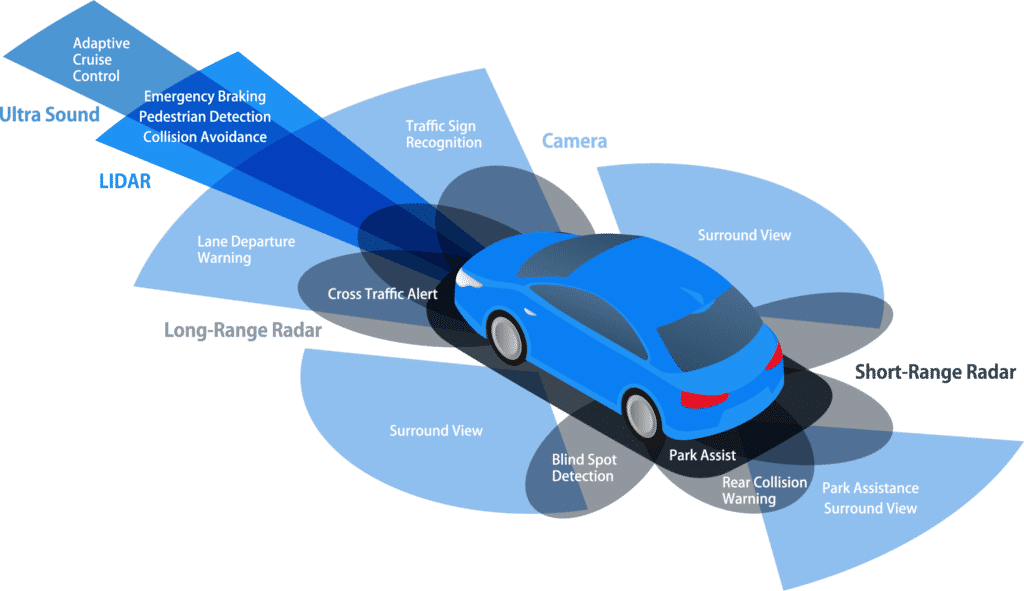If you think autonomous vehicles are a goal for the distant future, think again. At least one ADAS feature can be found in 92.7 percent of new vehicles sold in the United States. These systems are now the standard and their prevalence has completely altered the auto industry.
A Brief History of Automotive ADAS
How do we define ADAS? ADAS, or advanced driver assistance systems, are digital systems integrated into an automobile that assist drivers with their driving experience. Some of these systems simply provide information or perform easy driving tasks. These systems make the practice of driving more comfortable, simple, and safe.
ADAS systems appeared as far back as the 1970s, when anti-lock braking systems evolved to have computer-controlled sensors, and subsequently become more commonplace in automobiles. Standard cruise control and traction control followed close behind. Although these technologies may not fall under the umbrella of how we define ADAS systems today, they are early forms of the same functionality.
Ever-Evolving ADAS Auto Tech
ADAS from the ’70s pale in comparison to what they can do today. A good example is adaptive cruise control, which slows down and speeds up a vehicle based on surrounding cars. This system was developed primarily to avoid collisions, but it also increases fuel efficiency and improves traffic flow. These systems typically utilize a front radar sensor, a component responsible for monitoring the road ahead. If the sensor detects a slower vehicle within range, it will automatically slow the vehicle by engaging the brakes or letting off the accelerator. Additionally, a camera may be installed to help detect vehicles that may be unexpectedly merging into the driver’s lane. Volkswagen, Honda, and Hyundai are just a few automobile makers that offer this feature in many of their new vehicles.
Another example of a progressive ADAS is forward collision warning. Forward collision warning monitors the front of a vehicle and notifies the driver when they are too close to an obstacle ahead. In 2013 Subaru developed a forward collision warning feature that they call “EyeSight” which can detect pedestrians and cars. The system uses dual cameras mounted on the inside of the windshield. EyeSight can bring the car to a complete stop if necessary, to avoid a collision. Subaru reports that this system has reduced the rate of pedestrian-related insurance claims by 41 percent.
Some new high-end vehicles have introduced night vision. This ADAS feature uses a thermographic camera to help a driver see a further distance in poor weather conditions and low light. This has been achieved by using LiDAR (Light Detecting and Ranging), a technology new to ADAS, in conjunction with the typical camera and radar sensors. Audi, BMW, and Mercedes-Benz offer night vision in a few of their newest vehicles, but the technology is expected to be used by other manufacturers in the near future.
ADAS and Self-Driving Vehicles
These systems are revolutionary, but where do truly driverless cars come into play? ADAS make driverless cars possible. When many of these systems are working together the responsibility of the driver decreases. The more ADAS a vehicle has – the closer it is to driving itself.
There are different levels to the amount of automation a car has. ADAS begin to appear when level two is introduced. The higher the level, the more systems the vehicle has.
There are five levels of autonomous vehicles:
- Level 0: No Automation — Just your ordinary everyday car, which may have basic cruise control and anti-lock braking.
- Level 1: Driver Assistance — These systems offer assistance to drivers, but ultimately the driver still has complete control.
- Level 2: Partial Automation — Level two systems can control speed and steering, but the driver must still be at the wheel able to take control.
- Level 3: Conditional Automation — Cars with these systems could potentially drive themselves, but a driver override is still required.
- Level 4: High Automation — Level four cars drive themselves in most cases. A driver still has the option to manually override.
- Level 5: Full Automation — Truly driverless cars.
If you look at the road today the cars that you’ll see will be a mixture of levels 0-2. This is primarily due to legal and security concerns which have created hurdles in producing autonomous vehicles. But, that’s not to say that manufacturers aren’t moving in that direction.
Ford Motor Company and Volkswagen recently invested in Argo AI, an independent company that is developing a self-driving system to be used by manufacturers in their vehicles. Alternatively, some OEMs (Original Equipment Manufacturers) are taking matters into their own hands. Cruise – a subsidiary of General Motors announced the Origin earlier this year. This car is a level 5 autonomous driving vehicle that is completely driven through ADAS. The car doesn’t even have a steering wheel.
Read More: ADAS vs Autonomous Driving: What is the Role of ADAS in Autonomous Driving?
Law & Order: Automotive ADAS
OEMs are not the only ones invested in the future of autonomous vehicles. Governments are also pushing for their advancement to promote safe driving.
Automatic Emergency Braking (AEB)
These systems have proven to significantly prevent crashes and save lives. Studies by the Insurance Institute for Highway Safety have shown that cars with automatic emergency braking (AEB) systems have reduced the number of rear end collisions by 43 percent. Injuries in the same type of crashes fell 64 percent. For these reasons, there’s been a push by legislators and automakers to standardize this feature. In 2018 the National Highway Traffic Safety Administration orchestrated a voluntary commitment with OEMs that would include all new passenger vehicles with low-speed AEB by mid-2022.
V2V Communication
In 2016, the Federal Department of Transportation issued a Notice of Proposed Rulemaking (NPRM) that requires the standardization of V2V communication technology on all vehicles weighing less than 10,000 lbs. This ADAS technology known as vehicle-to-vehicle communications, or V2V, would allow vehicles to broadcast messages to each other at a rate of up to 10 times per second. These messages build a 360-degree awareness of all other vehicles within a range of over 300 meters.
The motivation behind this legislation is the reduction of road traffic crashes. The World Health Organization estimates that 1.35 million people die as a result of road traffic crashes every year. Widespread use of V2V communication allows drivers to anticipate many of these accidents before they occur and can significantly reduce the number of deaths and injuries from vehicle collisions.
This is just one example of an ADAS that government authorities have expressed interest in. Twenty-two U.S. states have authorized the operation of autonomous vehicles and many have issued executive orders allowing for testing and encouraging the advancement of fully autonomous vehicles.
The Future of ADAS Auto Repairs
With the implementation of this advanced technology also comes a need for regulation. These features rely heavily on advanced equipment such as cameras and RADAR. If a vehicle has been in a collision, it’s important that these systems are accurately calibrated and maintained. An ADAS sensor that’s left out of alignment can cause a significant amount of damage if it’s responsible for parking, steering, or determining the speed of a vehicle. As driverless vehicles emerge, proper care and maintenance become essential to safety.
There are four common types of ADAS sensor systems.
1. Camera
Camera sensors record high-definition video to process the area surrounding the car. These systems are ideal for detecting the shapes of objects but are not as effective when an object is a long distance away or in poor visibility conditions like bad weather.
2. RADAR
Radar (Radio Detection And Ranging) is able to look long distances to prevent hitting an object when a vehicle is moving at high speeds. RADAR sensors are still effective in bad weather and low light, but resolution leaves something to be desired. There are already many developers trying to improve the resolution of these sensors, something that would allow for the vehicle to better discern between certain objects in the surrounding area.
3. SONAR
In ADAS, SONAR sensors take the form of an ultrasonic sensing system. They use sound waves to measure the distance away from the vehicle and other objects by determining the amount of time it took for those waves to transmit. SONAR sensors are best close-range and are heavily utilized in parking assist ADAS.
4. LIDAR
LiDAR is the newest sensor in ADAS, having just become available on some high-end new vehicles. LiDAR stands for Light Detection and Ranging. It is a laser-based system that uses light to sense objects. It offers the benefits of cameras and radar by having the ability to create a 3D map of the area around a vehicle with even better resolution and accuracy. This system is highly efficient, but it comes at a cost. LiDAR is currently a very expensive technology to produce.
One of these systems is not more important than the rest. The ideal scenario for an autonomous vehicle is sensor fusion. When these ADAS sensors work together it creates sensor synergy, allowing the car to generate a full picture of the surrounding environment and produce the safest driving experience.

A fully automated vehicle would rely heavily on all ADAS sensors functioning perfectly, but it’s also essential for the sensors in a level 2 or level 3 vehicle to be properly maintained. This begs the question: will vehicle safety system recalibrations become as common as emission and safety tests?
Frequent safety checks have proven to reduce the number of accidents in vehicles with ADAS. It’s also worth noting that, like many other components of a vehicle, they are subject to the effects of age and wear from regular use. For these reasons, calibrating and validating vehicle safety systems annually could be a part of our future.
Read More: ADAS Sensors Guide
ADAS Calibration: Here & Now
Today, high-tech ADAS systems are not the standard for every car that enters a repair shop. But, these systems are becoming more accessible. To compete, repair shops need to learn how to perform these safety tests or find an ADAS partner to outsource them to. Car ADAS is at the forefront of this movement. For more information about calibration services we offer or licensing opportunities, please contact us.
Related Articles:







